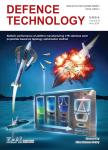Hypersonic impact flash characteristics of a long-rod projectile collision with a thin plate target
Hypersonic impact flash characteristics of a long-rod projectile collision with a thin plate target作者机构:State Key Laboratory of Explosion Science and TechnologyBeijing Institute of TechnologyBeijing 100081China
出 版 物:《Defence Technology(防务技术)》 (Defence Technology)
年 卷 期:2021年第17卷第2期
页 面:375-383页
核心收录:
学科分类:08[工学] 082603[工学-火炮、自动武器与弹药工程] 0826[工学-兵器科学与技术]
基 金:This work was supported by the National Key R&D Programof China(Grant No.2016YFC0801204) the National Programon Key Basic Research Project of China(973 Program,Grant No.613312)
主 题:Hypersonic impact flash Radiation intensity Impact flash mechanism Environmental luminescence
摘 要:Impact flash occurs when objects collide at supersonic speeds and can be used for real-time damage assessment when weapons rely on kinetic energy to destroy ***,the mechanism of impact flash remains unclear.A series of impact flash experiments of flat-head long-rod projectiles impacting thin target plates were performed with a two-stage light gas *** impact flash spectra for 6061 aluminum at 1.3e3.2 km/s collision speeds were recorded with a high-speed camera,a photoelectric sensor,and a time-resolved *** intensity of the impact flash exhibited a pulse characteristic with *** intensity(I)increased with impact velocity(V0)according to IfVn 0,where n?4.41 for V02 km/***,for V02 km/s,a continuous spectrum(thermal radiation background)was observed and increased in intensity with ***,for V02 km/s,only atomic line spectra were *** was no aluminum spectral lines for V02 km/s,which indicated that it had not been *** initial intense flash was emission from excited and ionized ambient gases near the impact surface,and had little relationship with shock temperature rise,indicating a new mechanism of impact flash.



